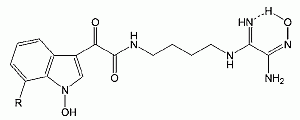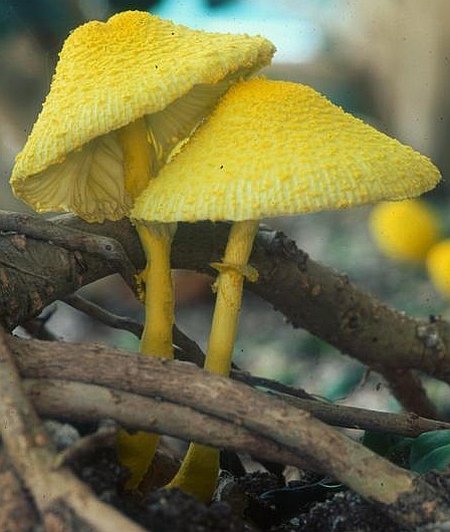The flower pot parasol, Leucocoprinus birnbaumii (Corda) Singer.
Synonyms
Agaricus aureus (Massee) F.M. Bailey
(1913)
Agaricus birnbaumii Corda
Icon. fung. (Prague) 3: 48 (1839)
Agaricus cepistipes var. luteus Bolton
Hist. fung. Halifax (Huddersfield) 3: 50 (1789)
Agaricus luteus With.
4: 233 (1796)
Bolbitius birnbaumii (Corda) Sacc. & Traverso
Syll. fung. (Abellini) 19: 151 (1910)
Lepiota aurea Massee
Bull. Misc. Inf., Kew: 189 (1912)
Lepiota cepistipes var. lutea (Bolton) Sacc.
Syll. fung. (Abellini) 5: 44 (1887)
Lepiota lutea (Bolton) Matt.
Bull. Soc. mycol. Fr. 13: 33 (1897)
Lepiota lutea (With.) Quél.
Lepiota pseudolicmophora Rea
Brit. basidiomyc. (Cambridge): 74 (1922)
Lepista lutea (With. ex Secr.) Godfrin
Leucocoprinus luteus (Bolton) Locq.
Bull. mens. Soc. linn. Lyon 14: 93 (1945)
Common names
Flower pot parasol
Lemon yellow Lepiota
Yellow pleated parasol
Plantpot dapperling
Yellow spirit umbrella
Goudgele plooiparasol (Dutch)
Keltaukonsieni (Finnish)
Gelber Faltenschirmling (German)

My name is Austin Collins.
I've dedicated my life to Mushrooms.
I believe Mushrooms are the best kept secret when it comes to health and well being.
For that reason, I would like to share a company with you that in my opinion makes the best mushroom products on the market.
The company is called Noomadic Herbals, my favorite supplement they make is called "Mushroom Total".
I take their products every day and they have helped me think better and have more energy. Give them a try.
-Austin
Description
Cap: 2-6 cm diameter, initially conical, then campanulate, fragile, margin striate, pale to bright yellow, sometimes with a darker-colored center, pruinose.
Gills: free, crowded, yellowish white.
Stem: 3-10 cm tall, 2-5 mm thick, slightly enlarged at the base, dry, smooth or pruinose.
Annulus: bright yellow, pruinose, moveable up and down the stalk, often breaking loose.
Spore print: white.
Spores: ellipsoid, with an apical pore, dextrinoid, 8-12 x 5-7 µm
Edibility: inedible; reported by some to be poisonous, i.e. causing gastrointestinal disturbance.
Habitat: single to several on rich organic matter or wet soil, common in greenhouses and potted plants; found outdoors in hot and wet weather, anytime indoors.
Originally a tropical fungus, it has been suggested (Watling, 2003) that the spores of the flow pot parasol have been spread worldwide through the distribution of plants and potting soils.
Bioactive compounds
The yellow pigments of this mushroom have been isolated and structurally characterized from a methanol extract. Named birnbaumin A and B, they are 1-hydroxyindoles – molecules that to our knowledge occur rarely in nature.

Medicinal properties
Antitumor effects
Polysaccharides extracted from the mycelial culture of L. binbaumii (as L. luteus) and administered intraperitoneally into white mice at a dosage of 300 mg/kg inhibited the growth of Sarcoma 180 and Ehrlich solid cancers by 70% and 80%, respectively (Ohtsuka et al., 1973).
Links
References
Bartsch A, Bross M, Spiteller P, Spiteller M, Steglich W.
Birnbaumin A and B: Two unusual 1-hydroxyindole pigments from the “flower pot parasol” Leucocoprinus birnbaumii.
Angew Chem Int Edit. 2005 44(19):2957-9.
Ohtsuka S, Ueno S, Yoshikumi C, Hirose F, Ohmura Y, Wada T, Fujii T, Takahashi E.
Polysaccharides having an anticarcinogenic effect and a method of producing them from species of Basidiomycetes.
UK Patent 1331513, 26 September 1973.
Reid DA, Eicker A.
South-African fungi. 2. Some species of Leucoagaricus and Leucocoprinus.
S Afr J Bot. 1993 59(1):85-97.
Sedivy J.
Leucocoprinus birnbaumii in a physician’s waiting room.
Mykologicky Sbornik. 1968 45(1-2):9-10.
Watling R.
A striking addition to the British mycoflora.
Mycologist. 1991 5(1):23.
Watling R. (2003).
Fungi.
The Natural History Museum: London. 96 pp.


